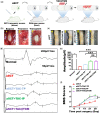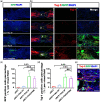Locally controlled release of immunosuppressive promotes survival of transplanted adult spinal cord tissue
- PMID: 36683735
- PMCID: PMC9845520
- DOI: 10.1093/rb/rbac097
Locally controlled release of immunosuppressive promotes survival of transplanted adult spinal cord tissue
Abstract
Transplantation of adult spinal cord tissue (aSCT) is a promising treatment for spinal cord injury (SCI) basing on various types of neural cells and matrix components inside aSCT. However, long-term systemic administration of immunosuppressors (e.g. tacrolimus, TAC) is required for the survival of allogeneic tissue, which often associated with severe side effects such as infection, liver damageand renal failure. In this study, a triglycerol monostearate (TGM)-based TAC delivery system (e.g. TAC@TGM) with high drug loading concentration was developed, which possessed injectable properties as well as sustainable and immune-responsive drug release behaviors. In complete transected SCI model, locally injected TAC@TGM could reduce the infiltration of inflammation cells, enhance the survival of transplanted aSCT (e.g. Tuj-1+ and NF+ neurons) and promote the recovery of locomotor function. Moreover, controlled release of TAC by TAC@TGM attenuated side effects of TAC on liver and kidneys compared with traditional systemic administration. More importantly, the developed TAC@TGM system provided a facile single dose of long-term immunosuppressive effect not just for aSCT transplantation, but also for other tissue/organ and cell transplantations.
Keywords: adult spinal cord tissue transplantation; controlled release; immune rejection; spinal cord injury; tacrolimus.
© The Author(s) 2022. Published by Oxford University Press.
Figures










Similar articles
-
Adult spinal cord tissue transplantation combined with local tacrolimus sustained-release collagen hydrogel promotes complete spinal cord injury repair.Cell Prolif. 2023 May;56(5):e13451. doi: 10.1111/cpr.13451. Epub 2023 Mar 13. Cell Prolif. 2023. PMID: 36916024 Free PMC article.
-
Allotransplantation of adult spinal cord tissues after complete transected spinal cord injury: Long-term survival and functional recovery in canines.Sci China Life Sci. 2020 Dec;63(12):1879-1886. doi: 10.1007/s11427-019-1623-5. Epub 2020 May 6. Sci China Life Sci. 2020. PMID: 32382980
-
Effective long-term immunosuppression in rats by subcutaneously implanted sustained-release tacrolimus pellet: effect on spinally grafted human neural precursor survival.Exp Neurol. 2013 Oct;248:85-99. doi: 10.1016/j.expneurol.2013.05.017. Epub 2013 Jun 5. Exp Neurol. 2013. PMID: 23748136
-
Tacrolimus-Eluting Disk within the Allograft Enables Vascularized Composite Allograft Survival with Site-Specific Immunosuppression without Systemic Toxicity.Pharm Res. 2022 Sep;39(9):2179-2190. doi: 10.1007/s11095-022-03345-4. Epub 2022 Aug 2. Pharm Res. 2022. PMID: 35915321
-
Multifaceted Roles of cAMP Signaling in the Repair Process of Spinal Cord Injury and Related Combination Treatments.Front Mol Neurosci. 2022 Feb 23;15:808510. doi: 10.3389/fnmol.2022.808510. eCollection 2022. Front Mol Neurosci. 2022. PMID: 35283731 Free PMC article. Review.
Cited by
-
A lipid/PLGA nanocomplex to reshape tumor immune microenvironment for colon cancer therapy.Regen Biomater. 2024 Mar 28;11:rbae036. doi: 10.1093/rb/rbae036. eCollection 2024. Regen Biomater. 2024. PMID: 38628547 Free PMC article.
-
Reshaping transplantation with AI, emerging technologies and xenotransplantation.Nat Med. 2025 Jul;31(7):2161-2173. doi: 10.1038/s41591-025-03801-9. Epub 2025 Jul 14. Nat Med. 2025. PMID: 40659768 Review.
-
Self-Healing COCu-Tac Hydrogel Enhances iNSCs Transplantation for Spinal Cord Injury by Promoting Mitophagy via the FKBP52/AKT Pathway.Adv Sci (Weinh). 2025 Jan;12(3):e2407757. doi: 10.1002/advs.202407757. Epub 2024 Nov 25. Adv Sci (Weinh). 2025. PMID: 39587837 Free PMC article.
-
Sustained delivery of NT-3 and curcumin augments microenvironment modulation effects of decellularized spinal cord matrix hydrogel for spinal cord injury repair.Regen Biomater. 2024 Apr 10;11:rbae039. doi: 10.1093/rb/rbae039. eCollection 2024. Regen Biomater. 2024. PMID: 38746707 Free PMC article.
References
-
- Liu D, Shen H, Shen Y, Long G, He X, Zhao Y, Yang Z, Dai J, Li X.. Dual-cues laden scaffold facilitates neurovascular regeneration and motor functional recovery after complete spinal cord injury. Adv Healthc Mater 2021;10:e2100089. - PubMed
-
- Sofroniew MV. Dissecting spinal cord regeneration. Nature 2018;557:343–50. - PubMed
-
- Reier PJ, Perlow MJ, Guth L.. Development of embryonic spinal cord transplants in the rat. Brain Res 1983;312:201–19. - PubMed
-
- Jakeman LB, Reier PJ.. Axonal projections between fetal spinal cord transplants and the adult rat spinal cord: a neuroanatomical tracing study of local interactions. J Comp Neurol 1991;307:311–34. - PubMed
LinkOut - more resources
Full Text Sources

